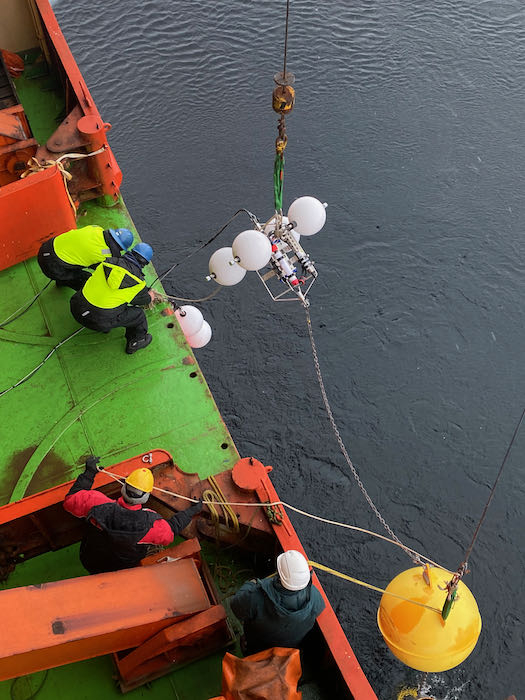In my 9-19-21 Journal - "A Tense Evening for Science," I wrote about moorings. These are a series of devices and instruments attached to an anchor and strung along a cable that will be under the surface for two years. Twice in the last 3 days/nights - it's really hard to tell the difference (I was wide awake at 3:00 am - finished the 1st Harry Potter - but had trouble sleeping because it was so bright out. Solar noon was at 6:02 am, and it's 12:45 pm and already getting dark) - the crew deployed moorings at different stations. These processes take 7-8 hours and involve tremendous coordination between the chief scientist, other science party members, technicians, crane operators, and the ship's captain. It's like a Cirque du Soleil act, although not as entertaining.
 Scientists, technicians, and crane operators. Oh my!
Scientists, technicians, and crane operators. Oh my!
The instruments that were shipped to and tested in the Kirkenes warehouse are now ready to be attached at various positions along the cable.
 UAF Scientist Andrey Pnyushkov, Mooring Technician Jack Greenberg, and Technical Group Team Leader John Kemp prepare the profiler for the mooring. This instrument will move up and down continuously over the two year deployment.
UAF Scientist Andrey Pnyushkov, Mooring Technician Jack Greenberg, and Technical Group Team Leader John Kemp prepare the profiler for the mooring. This instrument will move up and down continuously over the two year deployment.
There are long spools of cable run through the winch and the A-frame on the back of the helicopter deck. Once everyone is ready, the anchor is attached first and lowered overboard. The technicians follow the chief scientist's instructions about position for each of the various devices. They measure off and mark these locations. When it's time to attach an instrument, the mooring techs secure it onto the cable, using a variety of clamps and chains - they have to withstand the currents, temperature, and pressure of the Arctic.
 Mooring operations on the helicopter deck. Notice how calm the weather looks.
Mooring operations on the helicopter deck. Notice how calm the weather looks.
On the deck below, other technicians and mechanics also attach instruments using cranes and a second winch for some moorings. Then, coordinating with the operators above, techs lower the line of instruments into the water.
 A MicroCat (used to take long-term measurements) is attached to a steel ball, which will help keep the instruments at the correct depth.
A MicroCat (used to take long-term measurements) is attached to a steel ball, which will help keep the instruments at the correct depth.
And because we're in the Arctic and now in the ice, they constantly have to communicate with the ship's captain to watch out for ice flows, use thrusters to keep the ice from moving into the mooring area, and reposition the ship if it starts drifting. This is no easy feat!
 The steel ball is lowered from the A-frame. The weather conditions during this deployment were not quite as calm. The captain has to constantly be on watch for changing ice conditions.
The steel ball is lowered from the A-frame. The weather conditions during this deployment were not quite as calm. The captain has to constantly be on watch for changing ice conditions.
Once the mooring is in position, the technicians then perform a triangulation procedure. They ping (send signals to) the instruments to verify location. Then the captain navigates to several different areas (in essence driving around in circles) repeating the procedure so that the exact location is recorded. After all, they have to be able to find this precise spot 2 years from now when they hope to recover the data.
 The shiptrack during the triangulation process. No, we weren't lost.
The shiptrack during the triangulation process. No, we weren't lost.

Add new comment